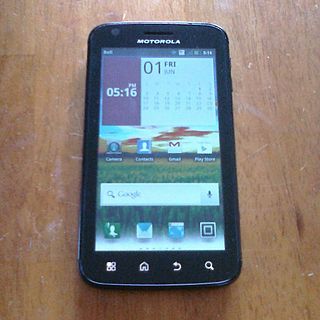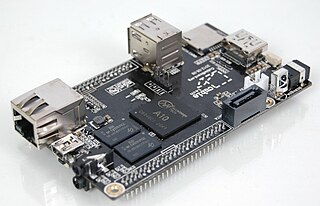Related Research Articles
Atmel ARM-based processors are microcontrollers and microprocessors integrated circuits, by Microchip Technology, that are based on various 32-bit ARM processor cores, with in-house designed peripherals and tool support.
The i.MX range is a family of Freescale Semiconductor proprietary microcontrollers for multimedia applications based on the ARM architecture and focused on low-power consumption. The i.MX application processors are SoCs (System-on-Chip) that integrate many processing units into one die, like the main CPU, a video processing unit, and a graphics processing unit for instance. The i.MX products are qualified for automotive, industrial, and consumer markets. Most of them are guaranteed for a production lifetime of 10 to 15 years.
Devices that use i.MX processors include Ford Sync, the Amazon Kindle and Kobo eReader series of e-readers until 2021, Zune, Sony Reader, Onyx Boox readers/tablets, SolidRun SOM's, Purism's Librem 5, some Logitech Harmony remote controls and Squeezebox radio and some Toshiba Gigabeat MP4 players. The i.MX range was previously known as the "DragonBall MX" family, the fifth generation of DragonBall microcontrollers. i.MX originally stood for "innovative Multimedia eXtension".

Moblin, short for 'mobile Linux', is a discontinued open source operating system and application stack for Mobile Internet Devices (MIDs), netbooks, nettops and embedded devices.

Tegra is a system on a chip (SoC) series developed by Nvidia for mobile devices such as smartphones, personal digital assistants, and mobile Internet devices. The Tegra integrates an ARM architecture central processing unit (CPU), graphics processing unit (GPU), northbridge, southbridge, and memory controller onto one package. Early Tegra SoCs are designed as efficient multimedia processors. The Tegra-line evolved to emphasize performance for gaming and machine learning applications without sacrificing power efficiency, before taking a drastic shift in direction towards platforms that provide vehicular automation with the applied "Nvidia Drive" brand name on reference boards and its semiconductors; and with the "Nvidia Jetson" brand name for boards adequate for AI applications within e.g. robots or drones, and for various smart high level automation purposes.

The BeagleBoard is a low-power open-source single-board computer produced by Texas Instruments in association with Digi-Key and Newark element14. The BeagleBoard was also designed with open source software development in mind, and as a way of demonstrating the Texas Instrument's OMAP3530 system-on-a-chip. The board was developed by a small team of engineers as an educational board that could be used in colleges around the world to teach open source hardware and software capabilities. It is also sold to the public under the Creative Commons share-alike license. The board was designed using Cadence OrCAD for schematics and Cadence Allegro for PCB manufacturing; no simulation software was used.

DisplayLink is a semiconductor and software technology company owned by Synaptics that develops the DisplayLink USB graphics technology. This technology enables computers and displays to connect using USB, Ethernet, and WiFi, and also allows for multiple displays to be connected to a single computer. DisplayLink's primary customers include notebook OEMs, LCD monitor manufacturers, and PC accessory vendors, and their technology is compatible with a wide range of operating systems, including Microsoft Windows, macOS, Android, ChromeOS, and Linux.
Rockchip is a Chinese fabless semiconductor company based in Fuzhou, Fujian province. Rockchip has been providing SoC products for tablets & PCs, streaming media TV boxes, AI audio & vision, IoT hardware since founded in 2001. It has offices in Shanghai, Beijing, Shenzhen, Hangzhou and Hong Kong. It designs system on a chip (SoC) products, using the ARM architecture licensed from ARM Holdings for the majority of its projects.

Linaro is an engineering organization that works on free and open-source software such as the Linux kernel, the GNU Compiler Collection (GCC), QEMU, power management, graphics and multimedia interfaces for the ARM family of instruction sets and implementations thereof as well as for the Heterogeneous System Architecture (HSA). The company provides a collaborative engineering forum for companies to share engineering resources and funding to solve common problems on ARM software. In addition to Linaro's collaborative engineering forum, Linaro also works with companies on a one-to-one basis through its Services division.

The PandaBoard was a low-power single-board computer development platform based on the Texas Instruments OMAP4430 system on a chip (SoC). The board has been available to the public at the subsidized price of US$174 since 27 October 2010. It is a community supported development platform.

The Motorola Atrix 4G is an Android-based smartphone developed by Motorola, introduced at CES 2011 along with the Motorola Xoom, Motorola Droid Bionic, and Motorola Cliq 2 on January 5, 2011. It was made available in the first quarter of 2011.
Onyx Boox is a brand of e-book reader produced by Onyx International Inc, based in China. Like most e-book readers, the Boox uses electronic paper technology.

The Allwinner A1X is a family of single-core SoC devices designed by Allwinner Technology from Zhuhai, China. Currently the family consists of the A10, A13, A10s and A12. The SoCs incorporate the ARM Cortex-A8 as their main processor and the Mali 400 as the GPU.
The MK802 is a PC-on-a-stick produced by Rikomagic, a Chinese company using mostly two series of systems on a chip architectures:

A stick PC or PC on a stick is a single-board computer in a small elongated casing resembling a stick, that can usually be plugged directly into an HDMI video port. A stick PC is a device which has independent CPUs or processing chips and which does not rely on another computer. It should not be confused with passive storage devices such as thumb drives.

Cubieboard is a single-board computer, made in Zhuhai, Guangdong, China. The first short run of prototype boards were sold internationally in September 2012, and the production version started to be sold in October 2012. It can run Android 4 ICS, Ubuntu 12.04 desktop, Fedora 19 ARM Remix desktop, Armbian, Arch Linux ARM, a Debian-based Cubian distribution, FreeBSD, or OpenBSD.

Allwinner Technology Co., Ltd is a fabless semiconductor company that designs mixed-signal systems on a chip (SoC). The company is headquartered in Zhuhai, Guangdong, China. It has a sales and technical support office in Shenzhen, Guangdong, and logistics operations in Hong Kong.

Amlogic Inc. is a Fabless semiconductor company that was founded on March 14, 1995, in Santa Clara, California and is predominantly focused on designing and selling system on a chip integrated circuits. Like most Fabless companies in the industry, the company outsources the actual manufacturing of its chips to third-party independent chip manufacturers such as TSMC. Its main target applications as of 2021 are entertainment devices such as Android TV-based devices and IPTV/OTT set-top boxes, media dongles, smart TVs and tablets. It has offices in Shanghai, Shenzhen, Beijing, Xi'an, Chengdu, Hefei, Nanjing, Qingdao, Taipei, Hong Kong, Seoul, Mumbai, London, Munich, Indianapolis, Milan, Novi Sad and Santa Clara, California.

The Rockchip RK3288 is an ARM architecture System on Chip (SoC) from Rockchip. It is the first SoC, in August 2014, that uses the 32-bit ARM Cortex-A17 processor. It is a quad-core processor with a NEON coprocessor and hardware acceleration for video and 3D graphics. It is used in a number of Chromebooks and other low-power, low-performance devices.
Pine Store Limited, known by its trade name Pine64, is a Hong Kong-based organization that designs, manufactures, and sells single-board computers, notebook computers, as well as smartwatch/smartphones. Its name was inspired by the mathematical constants pi and e with a reference to 64-bit computing power.
References
- ↑ "FXI's Cotton Candy could turn every screen you own into a cloud client". Engadget.com. Retrieved 2016-07-16.
- ↑ "FXI Technology Cotton Candy Cstick - PC & Network Downloads - PCWDLD.com". Fxitech.com. 12 January 2016. Retrieved 2016-07-16.
- ↑ [%= data.comment.created_on %] (18 November 2011). "FXI's Cotton Candy: it's a dual-core Android PC on a USB stick (hands-on pictures)". The Verge. Retrieved 2016-07-16.
- ↑ Wong, George (2011-11-18). "FXI Cotton Candy is Android on a USB stick". Ubergizmo.com. Retrieved 2016-07-16.
- 1 2 "FXI's Cotton Candy gets a taste of Ice Cream Sandwich and Ubuntu, we go hands-on". Engadget.com. 2012-01-10. Retrieved 2016-07-16.
- 1 2 "FXI Demos Two New Flavors of Cotton Candy Any Screen Connected USB Device - Ubuntu and Android 4.0 - MarketWatch". Archived from the original on 2012-01-14. Retrieved 2012-01-11.
- ↑ "FXI Cotton Candy Demo: More Power than You Can Shake a (Thumb) Stick at". Anandtech.com. Retrieved 2016-07-16.
- ↑ "Cotton Candy: Funny Name, Dual-core Android on a USB Stick". Anandtech.com. Retrieved 2016-07-16.
- ↑ "USB stick packs ARM Cortex-A9 CPU, runs Android or Ubuntu - News - Linux for Devices". Archive.is. Archived from the original on 2012-09-05. Retrieved 2016-07-16.
{{cite web}}: CS1 maint: bot: original URL status unknown (link) - ↑ "FXI Introduces Cotton Candy – Dual-core Android Device Inside a USB Stick". Phandroid.com. 2011-11-18. Retrieved 2016-07-16.
- ↑ Lee, Kevin (2011-11-18). "Meet Cotton Candy, the Dual-Core Android USB Device". PCWorld. Archived from the original on 2012-08-20. Retrieved 2016-07-16.
- ↑ Julian Horsey (2011-11-18). "FXI Cotton Candy USB Stick Transforms Any Screen In To An Android System". Geeky-gadgets.com. Retrieved 2016-07-16.
- ↑ "FXI's Cotton Candy- USB Device with Difference". Newgadget.org. 2011-11-21. Archived from the original on 2014-01-06. Retrieved 2016-07-16.
- ↑ "Samsung readies dual-core ARM Cortex-A9 SoC with GPS - News - Linux for Devices". Archive.is. Archived from the original on 2012-09-04. Retrieved 2016-07-16.
{{cite web}}: CS1 maint: bot: original URL status unknown (link) - ↑ Udalov, Alexander. "FXI Demos Ubuntu and Android 4.0 on its Cotton Candy USB Device - Mobile Magazine". Mobilemag.com. Archived from the original on 2014-01-06. Retrieved 2016-07-16.
- ↑ Schulman, Jacob (2012-01-10). "FXI Technologies' Cotton Candy: Android 4.0 and Ubuntu on the world's smallest PC (hands-on)". The Verge. Retrieved 2016-07-16.
- ↑ "CandyStorage". Archived from the original on 2012-09-22. Retrieved 2012-09-19.
- ↑ "Announcements - The Brřnnřysund Register Centre". W2.brreg.no. Retrieved 2016-07-16.
- ↑ Miller, Michael J. (2012-01-04). "The Last Gadget Standing at CES 2012". Forwardthinking.pcmag.com. Archived from the original on 2014-01-06. Retrieved 2016-07-16.
- ↑ Raskin, Robin (2011-12-09). "10 Finalists". Last Gadget Standing. Archived from the original on 2014-01-06. Retrieved 2016-07-16.
- ↑ "Tech Events - CES, CTIA, Computex, Mobile World Congress, and More". Blog.laptopmag.com. Archived from the original on 2014-01-06. Retrieved 2016-07-16.
- ↑ "Top 10 Gadgets Launched @ CES 2012". Archived from the original on 2012-01-15. Retrieved 2012-01-12.
